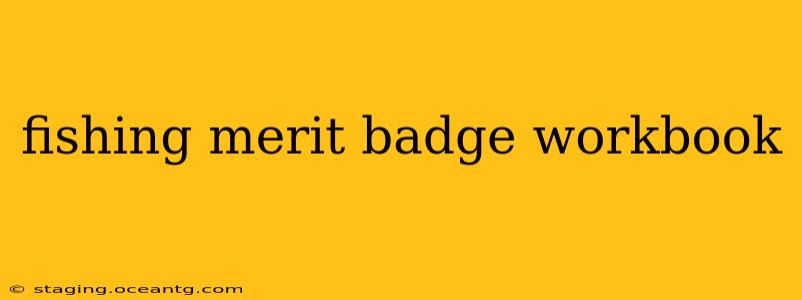Earning the Fishing merit badge is a rewarding experience, opening up a world of outdoor recreation and self-sufficiency. This comprehensive guide acts as your fishing merit badge workbook, walking you through the requirements and providing insights to help you successfully complete this challenging yet fulfilling merit badge. We'll cover everything from choosing the right equipment to understanding conservation practices, ensuring you're well-prepared for your journey into the world of angling.
What are the Requirements for the Fishing Merit Badge?
Before we dive into the specifics, let's outline the requirements for the Fishing merit badge. These requirements are designed to teach you the skills and knowledge necessary to fish responsibly and successfully. Your Scoutmaster will have the official requirements booklet, but generally, they include:
- Understanding Fishing Techniques: This includes learning different casting methods, knot tying, and understanding the behavior of fish.
- Equipment Knowledge: Knowing how to select and maintain appropriate fishing gear.
- Conservation Practices: Learning about responsible fishing practices and protecting aquatic environments.
- Safety Procedures: Understanding and practicing safe fishing habits.
- Fish Identification: Being able to identify common fish species in your area.
- Practical Fishing Experience: Successfully catching and releasing (or keeping, per regulations) fish.
Choosing the Right Fishing Gear: Rods, Reels, and Lines
Selecting the right fishing gear is crucial for a successful fishing experience. This section will help you understand the different types of equipment and how to choose the right one for your needs.
Rods: What type of rod is best for me?
The type of rod you choose depends heavily on the type of fishing you'll be doing. Spin casting rods are versatile and popular for beginners, while fly fishing rods require more specialized skill. Consider the length, action (how much the rod bends), and material (graphite or fiberglass) when making your selection.
Reels: Spinning vs. Baitcasting
Spinning reels are generally easier to learn, while baitcasting reels offer more control but require practice. Consider your skill level and the type of fishing you'll be doing when choosing a reel.
Lines: Choosing the Right Line Weight
Line weight is crucial for matching your rod and reel, as well as the type of fish you are targeting. Thicker lines are stronger but less sensitive, while thinner lines are more sensitive but can break more easily.
Mastering Essential Fishing Knots
Knowing how to tie reliable knots is essential for any angler. Practice tying these essential knots until you can do them quickly and efficiently:
- Improved Clinch Knot: A versatile knot for attaching lures and hooks to your fishing line.
- Palomar Knot: Another strong and reliable knot for attaching lures and hooks.
- Blood Knot: Used for joining two lines of different diameters.
Understanding Fish Behavior and Habitats
Fish behavior is influenced by a variety of factors, including water temperature, food availability, and the time of day. Understanding these factors can greatly improve your chances of catching fish.
What are the best times to fish?
Fish are most active during dawn and dusk, but this can vary depending on the species and water conditions. Learning about the feeding habits of your target fish is key.
How does weather affect fish behavior?
Changes in weather, like barometric pressure and temperature, can significantly impact fish activity. Learn to read weather patterns and adjust your fishing strategy accordingly.
Responsible Fishing Practices and Conservation
Responsible fishing is vital for maintaining healthy fish populations and protecting aquatic ecosystems.
Catch and Release Techniques: How to minimize harm to fish
Proper catch and release techniques, such as using barbless hooks and handling fish gently, are crucial for ensuring the survival of released fish.
Understanding Fishing Regulations: Size and bag limits
Familiarize yourself with local fishing regulations, including size and bag limits, to ensure you're fishing responsibly and legally.
Protecting Aquatic Habitats: Minimize your environmental impact
Practice Leave No Trace principles when fishing. Dispose of trash properly, avoid disturbing sensitive habitats, and respect the environment.
Identifying Common Fish Species
Learn to identify common fish species in your area. This will improve your fishing success and help you understand the local ecosystem better. Use field guides and online resources to learn to identify fish based on their physical characteristics.
Practical Fishing Experience: Putting it All Together
The final requirement involves putting your knowledge and skills into practice. Practice different casting methods, try different lures and baits, and learn from your experiences. Remember to be patient and persistent—fishing can be challenging, but it's also incredibly rewarding.
This guide provides a solid foundation for your journey toward earning your Fishing merit badge. Remember to consult your Scoutmaster and the official merit badge pamphlet for the most up-to-date requirements and guidelines. Good luck and happy fishing!
